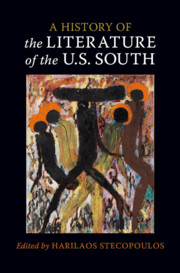Book contents
- A History of the Literature of the U.S. South
- A History of the Literature of the U.S. South
- Copyright page
- Contents
- Contributors
- Acknowledgements
- Introduction
- Chapter 1 Fictions of the Native South
- Chapter 2 John Smith and the English Origins of Southern Exceptionalism
- Chapter 3 Plantation and Enlightenment
- Chapter 4 Geoconfederacy
- Chapter 5 In the Shadow of His Office
- Chapter 6 Shadows of Haiti
- Chapter 7 “Midnight Bakings” Amid Starvation
- Chapter 8 A Calculated Fiction
- Chapter 9 Maroons and Marronage in Antebellum African American Literature
- Chapter 10 Everyday Literary Culture in the Nineteenth Century
- Chapter 11 Fables of the Bloody Shirt
- Chapter 12 A Heritage Unique in the Ages
- Chapter 13 Moonlight and Magnolias No More
- Chapter 14 Women Writers and the Southern Renaissance; or, the Work of Gender in Literary Periodization
- Chapter 15 Southern Geographies and New Negro Modernism
- Chapter 16 “A fine loud grabble and snatch of AAA and WPA”
- Chapter 17 Provincialism as a Positive Good
- Chapter 18 Faulkner’s Untimely Fiction
- Chapter 19 Reconsidering Du Bois’s “Central Text”
- Chapter 20 Cultural Activism and Theater of the Civil Rights Movement
- Chapter 21 Till the Hurt Becomes Music
- Chapter 22 Undead Sound
- Chapter 23 There Is No South
- Chapter 24 Hurricane Alley
- Select Bibliography
- Index
Chapter 24 - Hurricane Alley
Literature of the Coastal South in a Time of Climate Change
Published online by Cambridge University Press: 29 April 2021
- A History of the Literature of the U.S. South
- A History of the Literature of the U.S. South
- Copyright page
- Contents
- Contributors
- Acknowledgements
- Introduction
- Chapter 1 Fictions of the Native South
- Chapter 2 John Smith and the English Origins of Southern Exceptionalism
- Chapter 3 Plantation and Enlightenment
- Chapter 4 Geoconfederacy
- Chapter 5 In the Shadow of His Office
- Chapter 6 Shadows of Haiti
- Chapter 7 “Midnight Bakings” Amid Starvation
- Chapter 8 A Calculated Fiction
- Chapter 9 Maroons and Marronage in Antebellum African American Literature
- Chapter 10 Everyday Literary Culture in the Nineteenth Century
- Chapter 11 Fables of the Bloody Shirt
- Chapter 12 A Heritage Unique in the Ages
- Chapter 13 Moonlight and Magnolias No More
- Chapter 14 Women Writers and the Southern Renaissance; or, the Work of Gender in Literary Periodization
- Chapter 15 Southern Geographies and New Negro Modernism
- Chapter 16 “A fine loud grabble and snatch of AAA and WPA”
- Chapter 17 Provincialism as a Positive Good
- Chapter 18 Faulkner’s Untimely Fiction
- Chapter 19 Reconsidering Du Bois’s “Central Text”
- Chapter 20 Cultural Activism and Theater of the Civil Rights Movement
- Chapter 21 Till the Hurt Becomes Music
- Chapter 22 Undead Sound
- Chapter 23 There Is No South
- Chapter 24 Hurricane Alley
- Select Bibliography
- Index
Summary
“Hurricane Alley” ponders what happens when we define the literature of the coastal American South (Texas, Louisiana, Alabama, Mississippi, Florida, Georgia, and the Carolinas), as shaped by the paths, threats, and aftermaths of hurricanes. It explores what shifts in our understanding of the field if we consider Southern literature not solely in terms of plantation and Creolization, but also around a geography of vulnerability. It argues that coastal southern literature (and its resonances with the Caribbean) provides an apt example to reflect on the Anthropocene, climate change, and environmental racism. With a nineteenth- to twenty-first-century corpus featuring fiction, poetry, theater, visual arts, and cinema by George Washington Cable, Lafcadio Hearn, Zora Neale Hurston, Mark Twain, Tennessee Williams, Edwidge Danticat, Spike Lee, Patricia Smith, Kara Walker, Benh Zeitlin, Natasha Trethewey, Tiphanie Yanique, and Jesmyn Ward, the chapter expands the limits – generic, geographical, ethnic, generational, gendered, sexualized -- of southern literature.
Keywords
- Type
- Chapter
- Information
- A History of the Literature of the U.S. South , pp. 394 - 411Publisher: Cambridge University PressPrint publication year: 2021

